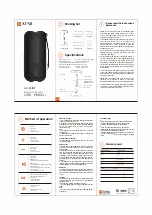
24 Connections and Placement
English
Listening Position
By now your speakers should be placed approximately two
to three feet from the front wall, the wall in front of the lis-
tening position, and about two feet from the side walls.
Your sitting distance should be further than the distance
between the speakers themselves. You are trying to attain the
impression of good center imaging and stage width.
There is no exact distance between speakers and listener, but
there is a relationship. In long rooms, naturally, that relationship
changes. The distance between the speakers will be far less than
the distance from you to the speaker system. However, in a wide
room, you will still find that if the distance from the listener to the
speakers becomes smaller than the distance between the speakers
themselves, the image will no longer focus in the center.
Now that you have positioned your speaker system, spend time
listening. Wait to make any major changes in your initial setup
for the next few days as the speaker system itself will change
subtly in its sound. Over the first 72 hours of play the actual
tonal quality will change slightly with deeper bass and more spa-
cious highs resulting. After a few days of listening you can begin
to make refinements and hear the differences.
The Wall Behind the Listener
Near-field reflections can also occur from your back wall
(the wall behind the listening position). If your listening posi-
tion is close to the back wall, these reflections can cause
problems and confuse imaging quality. It is better for the
wall behind you to be absorptive than to be reflective. If you
have a hard back wall and your listening position is close to
it, experiment with devices that will absorb information (i.e.
wall hangings and possibly even sound absorbing panels).
The Wall Behind the Speakers
The front surface, the wall behind the speakers, should not be
extremely hard or soft. A pane of glass will cause reflections,
brightness and confused imaging. Curtains, drapery and objects
such as bookshelves can be placed along the wall to diffuse an
overly reflective surface. A standard sheet rock or textured wall
is generally an adequate surface if the rest of the room is not too
bright and hard. Walls can also be too soft. If the entire front
wall consists of heavy drapery, your system can sound dull. You
may hear muted music with little ambience. Harder surfaces
will actually help in this case.
The front surface ideally should be one long wall without
any doors or openings. If you have openings, the reflection
and bass characteristics from each channel can be different.
The Side Walls
A good rule of thumb is to have the side walls as far away from the
speaker sides as possible. However, MartinLogan’s unique con-
trolled dispersion electrostatic transducer inherently minimizes
side wall reflections—a position as little as two feet from the side
walls often proves adequate. Sometimes, if the system is bright or
the imaging is not to your liking, and the side walls are very near,
try putting curtains or softening material directly to the edge of
each speaker. An ideal side wall, however, is no side wall at all.
Experimentation
Toe-in—
Now you can begin to experiment. First begin by toe-
ing your speakers in towards the listening area and then facing
them straight into the room. You will notice the tonal balance
and imaging changing. You will notice that as the speakers are
toed-in, the system becomes slightly brighter than when toed-
out. This design gives you the flexibility to compensate for a soft
or bright room.
Generally it is found that the ideal listening position is with the
speakers slightly toed-in so that you are listening to the inner
third of the curved transducer section. A simple, yet effective
method to achieve proper toe involves sitting at the listening
position, holding a flashlight under your chin and pointing it at
each speaker. The reflection of the flashlight should be within
the inner third of the panel (see figure 3).
Tilting the Speakers Backwards and Forwards—
As the
diagrams show in the Dispersion Interactions section of this
manual, the vertical dispersion is directional above and below
the stator panel itself. In some instances, if you are sitting close
to the floor, slight forward tilting of the speakers can enhance
clarity and precision.
Imaging—
In their final location, your Montis’s can have a stage
width somewhat wider than the speakers themselves. On well
recorded music, the instruments can extend beyond the edges
of each speaker (left and right), yet a vocalist should appear
directly in the middle. The size of the instruments should be nei-
ther too large nor too small, subject to the intent and results of
each unique audio recording.
Additionally, you should find good clues as to stage depth. Make
sure that the vertical alignment, distance from the front wall,
and toe-in is exactly the same for both speakers. This will greatly
enhance the quality of your imaging.
Bass Response—
Your bass response should neither be one
note nor should it be too heavy. It should extend to the deep-
est organ passages and yet be tight and well defined. Kick-drums
P
laCement
Содержание Montis
Страница 1: ...M o n t i s u s e r s m a n u a l m a n u e l d e l u t i l i s a t e u r tm ...
Страница 15: ...15 x 4 x1 x4 ...
Страница 16: ...16 29Hz 23kHz 3dB 58 lbs 26 3kg 4 Ohms 91dB 2 83 V M ...
Страница 17: ...17 ...
Страница 18: ...18 ...
Страница 19: ...19 ...
Страница 20: ...20 20 500W ...
Страница 26: ...26 Placement English Figure 3 Flashlight toe in technique ...
Страница 47: ...Français Figure 3 Technique d orientation avec lampe de poche Positionnement 47 ...
Страница 63: ......
















































